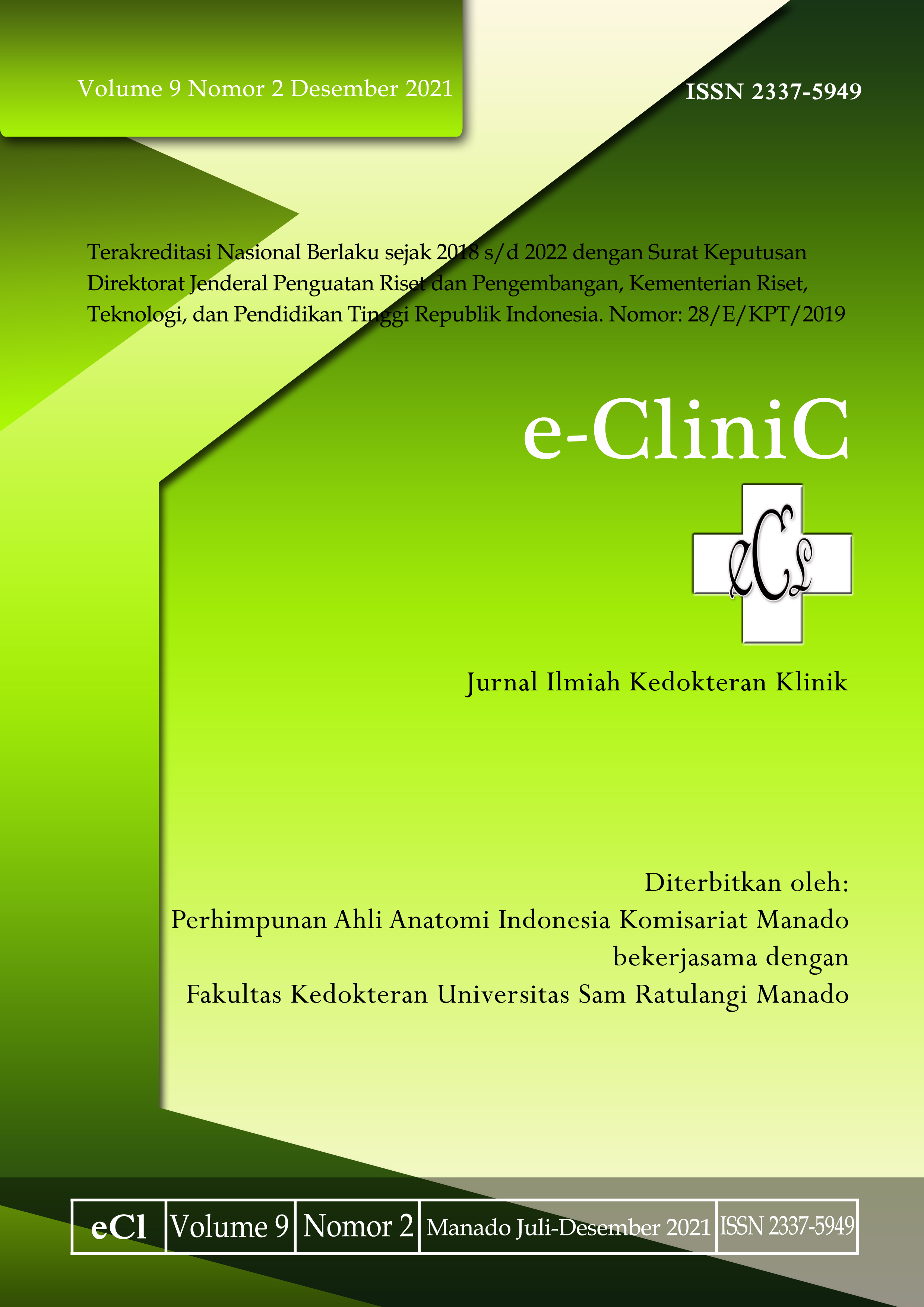Hubungan Faktor-faktor yang Berperan untuk Terjadinya Dismenore pada Remaja Putri di Era Normal Baru
DOI:
https://doi.org/10.35790/ecl.v9i2.34433Abstract
Abstract: Since Covid-19 is still a pandemic worldwide, people are required to familiarize themselves with new normal lifes or new normal conditions that have been implemented in Indonesia. Observation at Tincep Village of Minahasa during April to October 2020 revealed that the village government was very strict in implementing social restrictions; therefore, teenagers or young people were rarely doing physical activity outdoors. Moreover, teenagers with low physical activity tended to prefer indoor activities. This study was aimed to analyze the relationship between influencing factors of dysmenorrhea in female teenagers in the new normal era. This was a quantitative analytical and descriptive study with a cross sectional design. This study was conducted from November to December 2020 at Tincep Village. Subjects were 40 female teenagers aged 12-18 years. Independent variables were physical activity, nutritional status, age of menarche, length of menstruation, and depression meanwhile dependent variables was dysmenorrhea. Data were statistical analyzed univariately and bivariately. The results showed that significant relationships were only obtained between physical activity and depression and dysmenorrhea among female teenagers at Tincep Village, Minahasa in the new normal era. In conclusion, factors associated with dysmenorrhea were physical activity (most dominant) and depression meanwhile factors that were not associated with dysmenorrhea included nutritional status, age of menarche, and duration of menstruation.
Keywords: new normal; dysmenorrhea; Covid-19
Â
 Abstrak: Covid-19 masih menjadi wabah yang belum dapat diatasi di seluruh dunia. Oleh karena itu masyarakat dituntut untuk membiasakan diri dengan hidup new normal atau keadaan normal baru yang sudah diterapkan di Indonesia. Dari hasil pengamatan di desa Tincep Kabupaten Minahasa selama bulan April sampai Oktober 2020, ternyata pemerintah desa sangat ketat menjalankan kebijakan yaitu pembatasan sosial sehingga jarang remaja atau pemuda melakukan aktivitas fisik di luar rumah. Penelitian ini bertujuan untuk menganalisis hubungan faktor-faktor yang berperan untuk terjadinya dismenore pada remaja desa di era normal baru. Jenis penelitian ialah kuantitatif deskriptif analitik dengan desain potong lintang. Penelitian ini dilaksanakan di Desa Tincep Kabupaten Minahasa pada November - Desember 2020. Subyek penelitian ini yaitu 40 remaja putri yang berusia 12-18 tahun. Variabel bebas penelitian ini yaitu aktivitas fisik, status gizi, usia menarche, lama menstruasi, dan depresi dan variabel terikat ialah dismenore. Data hasil penelitian dianalisis secara univariat, bivariat, dan multivariat. Penyajian data dibuat dalam bentuk tabel dan narasi. Hasil penelitian ini menunjukkan bahwa hubungan bermakna hanya didapatkan antara aktivitas fisik dan depresi dengan dismenore pada remaja putri di Desa Tincep Kabupaten Minahasa di era normal baru. Simpulan penelitian ini ialah faktor-faktor yang berhubungan dengan dismenore ialah aktivitas fisik (yang terutama) dan depresi. Faktor-faktor yang tidak berhubungan dengan dismenore meliputi status gizi, usia menarche, serta lama menstruasi.
Kata kunci: new normal; dismenore; Covid-19
Downloads
Additional Files
Published
How to Cite
Issue
Section
License
COPYRIGHT
Authors who publish with this journal agree to the following terms:
Authors hold their copyright and grant this journal the privilege of first publication, with the work simultaneously licensed under a Creative Commons Attribution License that permits others to impart the work with an acknowledgment of the work's origin and initial publication by this journal.
Authors can enter into separate or additional contractual arrangements for the non-exclusive distribution of the journal's published version of the work (for example, post it to an institutional repository or publish it in a book), with an acknowledgment of its underlying publication in this journal.
Authors are permitted and encouraged to post their work online (for example, in institutional repositories or on their website) as it can lead to productive exchanges, as well as earlier and greater citation of the published work (See The Effect of Open Access).







